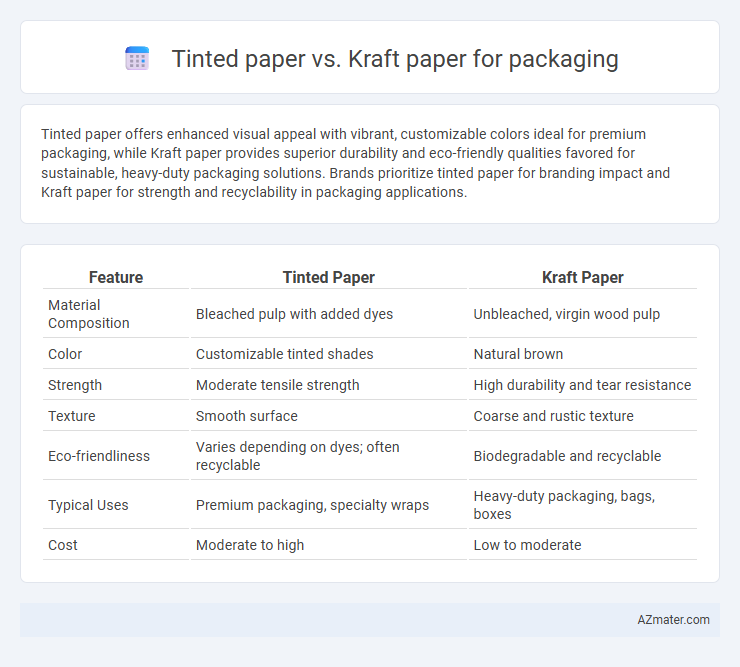Tinted paper offers enhanced visual appeal with vibrant, customizable colors ideal for premium packaging, while Kraft paper provides superior durability and eco-friendly qualities favored for sustainable, heavy-duty packaging solutions. Brands prioritize tinted paper for branding impact and Kraft paper for strength and recyclability in packaging applications.
Table of Comparison
| Feature | Tinted Paper | Kraft Paper |
|---|---|---|
| Material Composition | Bleached pulp with added dyes | Unbleached, virgin wood pulp |
| Color | Customizable tinted shades | Natural brown |
| Strength | Moderate tensile strength | High durability and tear resistance |
| Texture | Smooth surface | Coarse and rustic texture |
| Eco-friendliness | Varies depending on dyes; often recyclable | Biodegradable and recyclable |
| Typical Uses | Premium packaging, specialty wraps | Heavy-duty packaging, bags, boxes |
| Cost | Moderate to high | Low to moderate |
Introduction to Tinted Paper and Kraft Paper
Tinted paper features a subtle hue achieved through dyes or pigments, enhancing the visual appeal and brand differentiation in packaging applications. Kraft paper, made from unbleached wood pulp, offers superior strength, durability, and eco-friendly properties, making it ideal for heavy-duty packaging and sustainable product presentation. Both materials provide distinct advantages in packaging design, balancing aesthetics with functionality and environmental impact.
Key Differences Between Tinted Paper and Kraft Paper
Tinted paper offers a wide range of color options, enhancing brand visibility and aesthetic appeal, while kraft paper is typically brown and known for its durability and eco-friendliness due to its unbleached fibers. Tinted paper is often smooth and suited for high-quality printing, whereas kraft paper features a coarse texture that provides strength and resistance, ideal for heavy-duty packaging. The environmental impact also differs: kraft paper is biodegradable and recyclable, making it a preferred choice for sustainable packaging, while tinted paper may contain dyes and coatings that affect recyclability.
Aesthetic Appeal: Color Options and Customization
Tinted paper offers vibrant and diverse color options, enhancing packaging aesthetics with customizable hues that align with brand identity and attract consumer attention. Kraft paper provides a natural, rustic appearance with limited color variations, appealing to eco-conscious brands seeking an organic look. Customization on tinted paper allows for precise color matching and print designs, while kraft paper typically emphasizes texture and minimalist printing for a handcrafted feel.
Strength and Durability in Packaging
Tinted paper offers moderate strength suitable for lightweight packaging but lacks the durability required for heavy or long-term storage. Kraft paper, made from strong wood pulp fibers, provides superior tear resistance and high durability, making it ideal for packaging that demands protection during shipping and handling. Its robust structure ensures sustained performance under stress, outperforming tinted paper in strength and longevity for packaging applications.
Environmental Impact and Sustainability
Tinted paper often requires additional dyes and chemical treatments that can increase its environmental footprint compared to Kraft paper, which is typically unbleached and made from natural wood fibers. Kraft paper is widely recognized for its biodegradability, recyclability, and lower energy consumption during production, making it a more sustainable choice for eco-friendly packaging solutions. Brands seeking to minimize their carbon footprint and support circular economy principles frequently prefer Kraft paper due to its reduced impact on ecosystems and ability to decompose more rapidly in natural environments.
Cost Comparison: Tinted Paper vs Kraft Paper
Tinted paper generally incurs higher production costs due to added dyes and specialized coatings, making it pricier than kraft paper, which is made from unbleached wood pulp and utilizes a more economical manufacturing process. Kraft paper offers budget-friendly packaging solutions with strong durability and environmental benefits, driving lower overall expenses in bulk orders. Businesses aiming to minimize packaging costs often prefer kraft paper, whereas tinted paper is selected for its aesthetic appeal despite the higher price point.
Printability and Branding Opportunities
Tinted paper offers vibrant color options that enhance printability with sharp graphics and detailed logos, making it ideal for premium branding and eye-catching packaging. Kraft paper provides a natural, textured surface that supports eco-friendly branding but may require specialized inks for clear print results. Both materials cater to distinct brand identities, with tinted paper excelling in visual impact and kraft paper emphasizing sustainability and rustic aesthetics.
Uses and Applications in Packaging
Tinted paper is commonly used in packaging for its aesthetic appeal, making it ideal for luxury gift boxes, promotional packaging, and custom-branded wraps where color enhances product presentation. Kraft paper is favored for its durability and eco-friendly properties, widely applied in shipping bags, grocery bags, and heavy-duty packaging that requires tear resistance and sustainable materials. Both types serve distinct packaging needs, with tinted paper emphasizing visual impact and kraft paper prioritizing strength and environmental responsibility.
Consumer Perception and Market Trends
Tinted paper packaging offers a modern, vibrant appeal that attracts eco-conscious consumers seeking stylish yet sustainable options, while kraft paper conveys a natural, rustic feel associated with durability and environmental responsibility. Market trends indicate growing demand for kraft paper due to its biodegradable properties and strong brand association with authenticity and simplicity. Consumer perception favors tinted paper for premium products and gift packaging, whereas kraft paper dominates mass-market sectors emphasizing recyclability and cost-effectiveness.
Choosing the Right Paper for Your Packaging Needs
Tinted paper offers vibrant colors and customization options that enhance brand visibility, making it ideal for premium or visually impactful packaging. Kraft paper provides durability, eco-friendliness, and a natural appearance, suitable for sustainable and heavy-duty packaging needs. Selecting the right paper depends on product protection requirements, brand image, and environmental considerations.

Infographic: Tinted paper vs Kraft paper for Packaging
 azmater.com
azmater.com